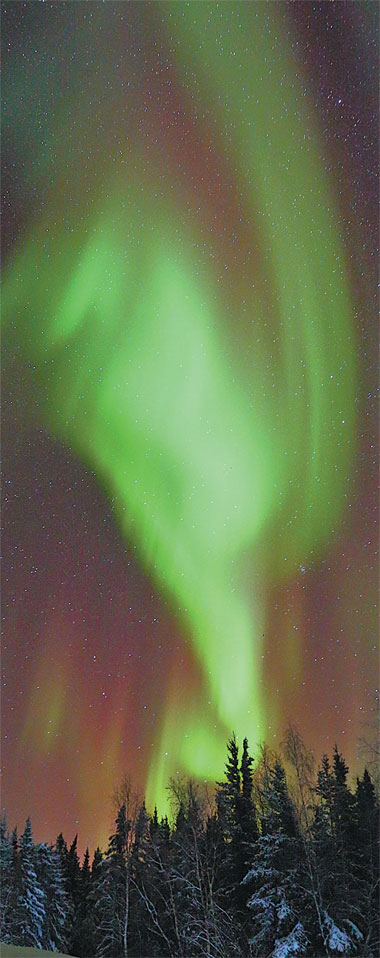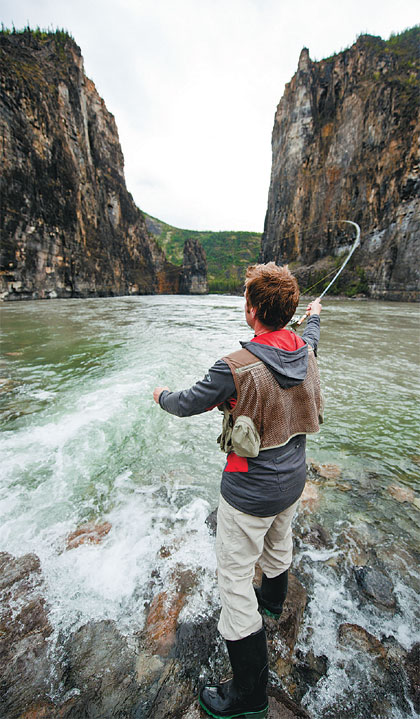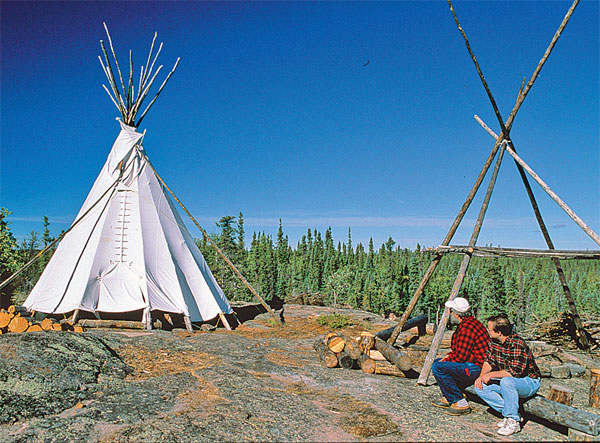Natural wonderland
Updated: 2014-02-09 08:40
By Mike Peters (China Daily)
|
|||||||||||
Canada's Northwest Territories offer travelers great escapes in winter and summer, with opportunities to shop in Vancouver on the way. Mike Peters reports.
Bob McLeod vividly remembers huddling with his boyhood friends in the twilight, waiting for the night sky to darken. The youngsters in a remote tribal village of Canada's Northwest Territories would fidget as the heavens first went black, then slowly became luminous with faint hints of yellow and green. Suddenly, the spirits made themselves known, as sheets of brilliant green fire filled the horizon. In another direction, daggers of yellow may have struck the Earth, or a curtain of bright crimson may have swirled in the sky. The aurora borealis ("Northern Lights") had arrived.
"As small boys, we were scared but very excited, too," says McLeod, now the premier of the sparsely populated province, on a recent visit to China. The spirits, he says, didn't always come with bad intentions. "We knew they were the reason that some of the finest diamonds in the world were under our land."
|
Ice fishing is an old tradition tourists can enjoy in winter. Photos provided to China Daily |
|
Summer hikers enjoy stunning mountain scenery in the Canadian Rockies. |
|
The aurora borealis is a major attraction in Canada's northwest. |
|
Fast-flowing rivers promise good summer fishing. |
|
Lodging ranges from rustic teepees to 5-star resorts. |
In fact, Canada's Northwest Territories province is the third-largest producer of diamonds in the world. It boasts 11 official languages, thanks to its seven indigenous peoples. Old traditions of hunting and trapping are vibrant today, and fine furs from Mackenzie Bay carry hefty price tags in luxury shops around the world.
Those are just a few of the fun facts McLeod has come to China to share about his province. For experienced tourists who are eager to escape the rat-race of big cities, McLeod promises a "magical" hunting or fishing adventure, or a wilderness tour by snowmobile, or grandly silent paddling by canoe under the midnight sun - any or all possible from a beautiful remote lodge that's warm and comfortable.
And all with those amazing Northern Lights overhead.
"There are other places that offer tourists a chance to see the aurora," says David Ramsay, the NWT's minister for tourism, "but we believe Yellowknife, our provincial capital, is the best place to see it in the world." That's not just homeboy bragging: A Japanese meteorologist's study indicates that Yellowknife offers a 92 percent likelihood to see the Arctic light show in season. That's because Yellowknife is far enough from the sea that cloud cover is rare.
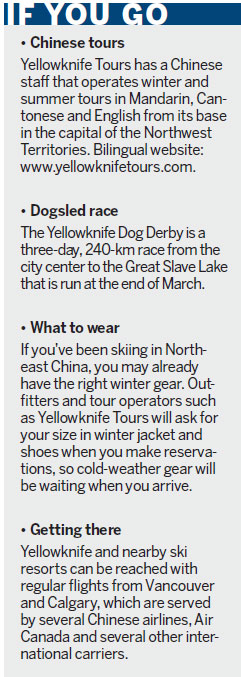
"That means if you are in Yellowknife for two or three days at the peak viewing time, you are guaranteed to see it," he says. "You can sit in your hot tub at your lodge, or relax in a heated chair on a 360-degree viewing deck.
"And you don't have to come in winter - you can see the lights in late summer, the end of August and all of September - so you can relax on a lodge deck to watch the show wearing shorts and drinking a beer."
The stunning mountain scenery offers more active fun, too: Skiing in easy reach, dogsledding, ice fishing, snow-shoeing and snowmobile riding. The air is clean and clear, the sky is blue, and Canada's great outdoors is a great escape from the pressures of urban life in a pristine environment.
"Canada has some of the best skiing in the world, especially in British Columbia and Alberta," says Derek Galpin, managing director for China of the Canadian Tourism Commission. "We've seen a growing trend in China - people wanting to ski, learning to ski - in fact, we've just done a number of promotions with the Nanshan ski resort just about an hour outside Beijing."
Many people in China have seen the TV show Canada, You Can Be A Star, he notes. "We just sent two very good Chinese skiers to Alberta in December, and those programs are being shown on the Travel Channel this month - right now."
And while the Northwest Territories are seductively remote, getting there is quite easy.
"There were 82 weekly flights to Canada in 2013," says Canadian ambassador to China Guy Saint-Jacques. Air Canada and several Chinese airlines offer direct flights to Vancouver from Beijing, Shanghai, Guangzhou, Shenyang and Chengdu - and from Vancouver there are many flights to Yellowknife and to popular ski areas in the region.
In fact, you can fly to Vancouver and then explore three mountains that are maybe only a half an hour from the center of Vancouver.
"You can be shopping at 2 o'clock in the afternoon on Robson Street, the main shopping street in Vancouver, and by 3:45 you can be skiing!" says Galpin.
Canada is well-known to Chinese, many of whom emigrated to the country's biggest cities of Toronto and Vancouver over the past century. In Yellowknife, Verda Law and other family members originally from Hong Kong operate a tour agency that caters to Chinese visitors - offering guides who speak Mandarin and Cantonese. Chinese food is available, and outfitters can offer winter gear and instruction for skiing, ice-fishing and other winter activities.
"Almost 300,000 Chinese tourists came to Canada last year," says Galpin, noting that the number has grown rapidly since the country won Approved Destination Status from the Chinese government in 2010. Tourism officials expect about 340,000 Chinese visitors this year, he says.
"Many of them will be experienced travelers who know destinations like Toronto and Vancouver very well," he says. "Niagara Falls near Toronto is an amazing sight, very different in summer and winter, but the Northwest Territories has the tallest waterfall in Canada - Victoria Falls - and no crowds. Maybe 1,000 people went there last year.
"So if people are looking for something new, especially independent travelers and people coming in small groups with friends and family, places like the Northwest Territories offer a great variety of experiences."
For nature lovers, those experiences include getting a close look at bears.
Driving from Banff to Jasper on the highway through the Rockies in the summertime you are likeliest to see brown bears.
For polar bears? "You'll want to go to Churchill in Manitoba later in the year," says Galpin. "In October or November, they are moving off the land, waiting for the Hudson Bay to freeze. You are 100 percent guaranteed to see them.
And you can get very close, very safely, he says.

"Big-wheeled tundra buggies scoot across the frozen ground, that haul 30 to 40 people very slowly across the tundra, and stop when they see a bear. The bear will come investigate, but the buggy always provides a barrier for safety.
"You are not allowed to get out of the tundra buggies, guides make sure people follow the rules," he adds with a grin. "Polar bears are not cuddly - they are dangerous wild animals that can eat you. Seeing them is one of the great thrills of out-of-the-way places in Canada."
Contact the writer at michaelpeters@chinadaily.com.cn.
(China Daily 02/09/2014 page10)
Today's Top News
Xi attends Sochi Olympic opening ceremony
Suspected hijacker seized
China changing the way it drinks
Senate confirms Baucus as ambassador to China
More Chinese enjoy festival overseas
Shanghai kindergartens to promote local dialect
Faulty Chinese part forces major Aston Martin recall
Daily stress taking toll on life at home: experts
Hot Topics
Lunar probe , China growth forecasts, Emission rules get tougher, China seen through 'colored lens', International board,
Editor's Picks

|

|
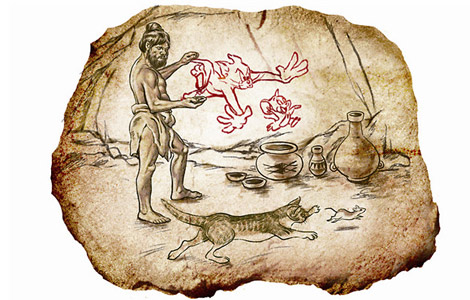
|
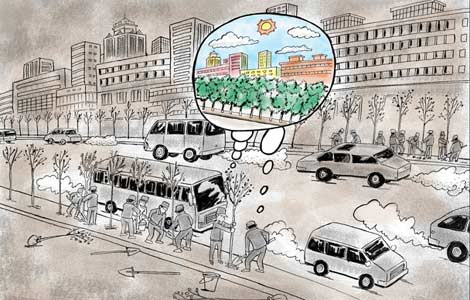
|

|

|


